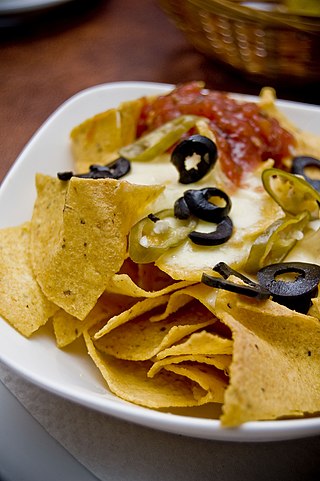
In cooking, a sauce is a liquid, cream, or semi-solid food, served on or used in preparing other foods. Most sauces are not normally consumed by themselves; they add flavor, moisture, and visual appeal to a dish. Sauce is a French word taken from the Latin salsa, meaning salted. Possibly the oldest recorded European sauce is garum, the fish sauce used by the Ancient Romans, while doubanjiang, the Chinese soy bean paste is mentioned in Rites of Zhou in the 3rd century BC.

Nachos are a Mexican culinary dish consisting of tortilla chips or totopos covered with cheese or cheese sauce, as well as a variety of other toppings and garnishes, often including meats, vegetables, and condiments such as salsa, guacamole, or sour cream. At its most basic form, nachos may consist of merely chips covered with cheese, and served as an appetizer or snack, while other versions are substantial enough as a main course. The dish was created by, and named after, Ignacio Anaya, who created them in 1941 for customers at the Victory Club restaurant in Piedras Negras, Coahuila.

Fry sauce is a condiment often served with French fries or tostones in many places in the world. It is usually a combination of one part tomato ketchup and two parts mayonnaise. Historically, the Argentinian salsa golf is most likely the first ketchup and mayonnaise sauce, having been invented in the 1920s by Luis Leloir.

Salsa is a variety of sauces used as condiments for tacos and other Mexican and Mexican-American foods, and as dips for tortilla chips. They may be raw or cooked, and are generally served at room temperature.

Chicken tikka masala is a dish consisting of roasted marinated chicken chunks in a spiced sauce. The sauce is usually creamy and orange-coloured. The dish was popularised by cooks from India living in Great Britain and is offered at restaurants around the world.

Fettuccine Alfredo or fettuccine al burro is an Italian pasta dish of fresh fettuccine tossed with butter and parmesan. As the cheese melts, it emulsifies the liquids to form a smooth and rich cheese sauce coating the pasta. The dish is named after Alfredo Di Lelio, who featured the dish at his restaurant in Rome in the early to mid-20th century; the "ceremony" of preparing it tableside was an integral part of the dish.

Eggs Benedict is a common American breakfast or brunch dish, consisting of two halves of an English muffin, each topped with Canadian bacon, a poached egg, and hollandaise sauce. It was popularized in New York City.

The cuisine of the Southwestern United States is food styled after the rustic cooking of the Southwestern United States. It comprises a fusion of recipes for things that might have been eaten by Spanish colonial settlers, cowboys, Native Americans, and Mexicans throughout the post-Columbian era; there is, however, a great diversity in this kind of cuisine throughout the Southwestern states.

Punta del Este is a seaside city and peninsula on the Atlantic Coast in the Maldonado Department of southeastern Uruguay. Starting as a small town, Punta del Este later became internationally known as a resort for the Latin and North American jet set and tourists. The city has been referred to as "the Monaco of the South", "The Pearl of the Atlantic", "the Hamptons of South America","the Miami Beach of South America", or "the St. Tropez of South America".

Mì Quảng, literally "Quảng noodles", is a Vietnamese noodle dish that originated from Quảng Nam Province in central Vietnam. In the region, it is one of the most popular and nationally recognized food items, and served on various occasions such as at family parties, death anniversaries, and Tết. Mì Quảng can both be found in many famous restaurants and street vendors among Central provinces, and is eaten for breakfast and lunch.

Uruguayan cuisine is a fusion of cuisines from several European countries, especially of Mediterranean foods from Spain, Italy, Portugal and France. Other influences on the cuisine resulted from immigration from countries such as Germany and Scotland. Uruguayan gastronomy is a result of immigration, rather than local Amerindian cuisine, because of late-19th and early 20th century immigration waves of, mostly, Italians. Spanish influences are very abundant: desserts like churros, flan, ensaimadas yoo (Catalan sweet bread), and alfajores were all brought from Spain. There are also all kinds of stews known as guisos or estofados, arroces, and fabada. All of the guisos and traditional pucheros (stews) are also of Spanish origin. Uruguayan preparations of fish, such as dried salt cod (bacalao), calamari, and octopus, originate from the Basque and Galician regions, and also Portugal. Due to its strong Italian tradition, all of the famous Italian pasta dishes are present in Uruguay including ravioli, lasagne, tortellini, fettuccine, and the traditional gnocchi. Although the pasta can be served with many sauces, there is one special sauce that was created by Uruguayans. Caruso sauce is a pasta sauce made from double cream, meat, onions, ham and mushrooms. It is very popular with sorrentinos and agnolotti. Additionally, there is Germanic influence in Uruguayan cuisine as well, particularly in sweet dishes. The pastries known as bizcochos are Germanic in origin: croissants, known as medialunas, are the most popular of these, and can be found in two varieties: butter- and lard-based. Also German in origin are the Berlinese known as bolas de fraile, and the rolls called piononos. The facturas were re-christened with local names given the difficult German phonology, and usually Uruguayanized by the addition of a dulce de leche filling. Even dishes like chucrut (sauerkraut) have also made it into mainstream Uruguayan dishes.

Chicken parmesan, or chicken parmigiana, is a dish that consists of breaded chicken breast covered in tomato sauce and mozzarella, parmesan, or provolone cheese. A quantity of ham or bacon is sometimes added.

Salsa golf is a cold sauce of somewhat thick consistency, common in Argentina. It is made from mayonnaise with a smaller amount of tomato-based sauce such as ketchup, as well as seasonings including pimento, oregano, and cumin.

Marie Rose sauce is a British condiment often made from a blend of tomatoes, mayonnaise, Worcestershire sauce, lemon juice and black pepper. A simpler version can be made by merely mixing tomato ketchup with mayonnaise. The sauce was popularised in the 1960s by Fanny Cradock, a British celebrity chef.
Dan Coudreaut is an American chef. He was the executive chef and vice president of culinary innovation at McDonald's from 2004 to 2018.

Wasakaka is a savory sauce found in Dominican and Venezuelan cuisine. The name is also spelled guasacaca, pronounced the same. It is often used in chicken dishes.

Genovese sauce is a slow-cooked onion and meat sauce associated with Italy's Campania region, especially Naples — typically served with paccheri, ziti or candele pasta — and sprinkled with grated cheese.

















